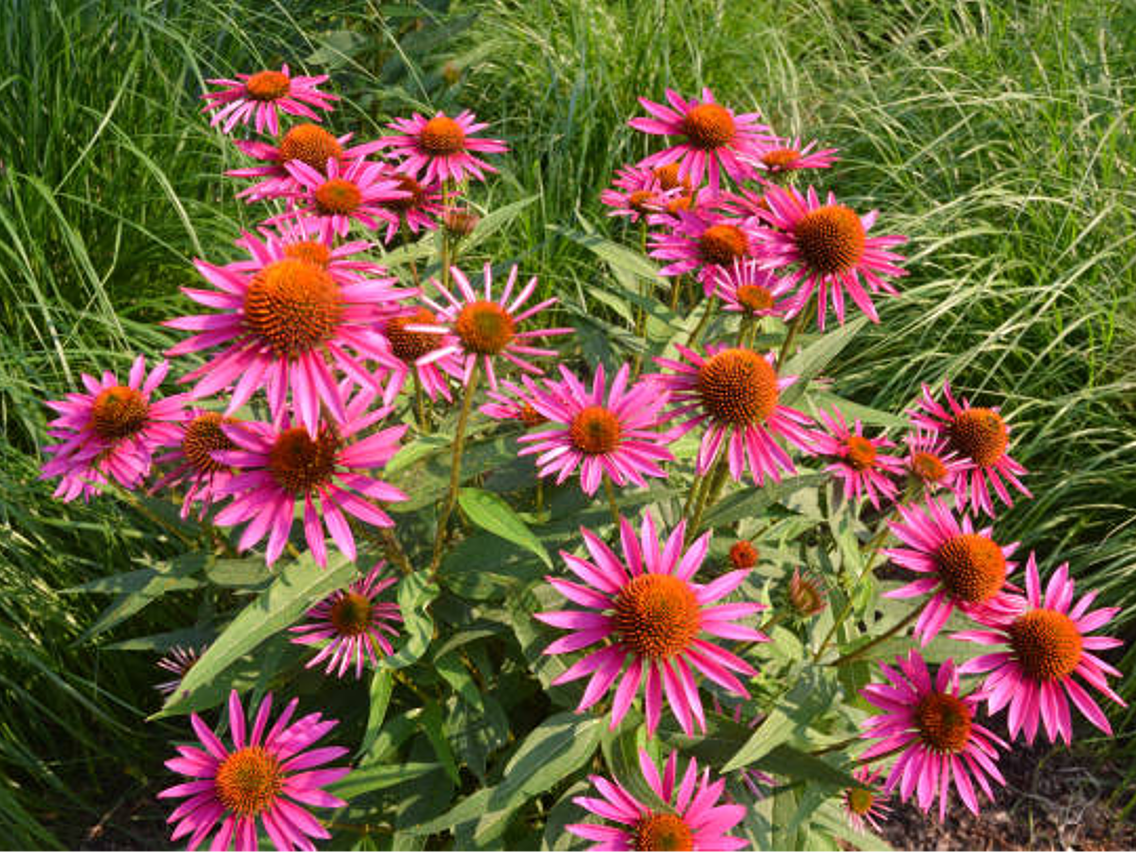Echinacea purpurea - Purple Coneflower

Common Names: Echinacea, Purple Coneflower, Eastern Purple Coneflower, Coneflower, Echinacea purpurea, Black Samson, American Coneflower, North American Coneflower, Ornamental Plant
Latin Name: Echinacea purpurea
Origin: Asia, Australia, Europe, South America, North America
Short Introduction
Purple Coneflower is cultivated both as an ornamental plant—often featured in borders and group plantings—and as a valued medicinal herb. Garden cultivars offer a wide variety of colors and growth habits. When it comes to growing, this perennial is extremely hardy and undemanding. While it prefers sunny locations and well-drained soils, it tolerates poor (low-nutrient) soils and can be grown in drier or partly shaded sites as well. Propagation is by seed, root division, or cuttings. Echinacea should not be planted exclusively in full shade, regardless of soil moisture. In the right conditions, it is capable of withstanding extended dry periods. Planting is best done in spring or autumn, either as clumps or small bushes. Shoots around 10 cm tall generally thrive if planted in late autumn or early winter. The greatest germination success is observed during the day when temperature fluctuations are largest (e.g., 8°C in the morning and 25°C in the afternoon).
Detailed Description
A resilient herb known for boosting the immune system, cherished by Native Americans for generations.
Botanical Information
Purple Coneflower (Echinacea purpurea) is a perennial that typically grows to a height of about 1 meter (average between 120–160 cm), with an upright stem and a roughly hairy surface. The leaves are stalked, lanceolate to ovate, with serrated edges and both sides usually hairy. The flower heads are composed of individual purple ray florets and tubular brown disc florets on a conical receptacle; all flowers are bisexual. Blooming occurs from July through September, with pollination performed by bees and butterflies.
Origin and Distribution
Purple Coneflower is native to the prairies of North America, where it was used for generations by Indigenous tribes. Its wider recognition in Europe and across the globe was significantly influenced by Joseph Meyer, who learned about its beneficial properties from Native Americans and helped spread this knowledge.
Usage / Dosage
Traditional usage recommends Purple Coneflower for the onset of symptoms such as colds, upper and lower respiratory tract infections, and urinary tract infections. Other texts mention its usefulness in treating any respiratory infection. All sources agree that Purple Coneflower is traditionally employed when infectious illnesses compromise immune function.
It is well-documented that North American Indigenous peoples used Purple Coneflower for many ailments, from everyday issues such as runny nose, colds, healing of minor wounds, and inflammations, to more serious concerns like snake bites, treatment of sexually transmitted diseases, and skin problems in horses. Poultices with Purple Coneflower were applied after insect stings and burns. Chewing the root was believed to ease toothaches and throat infections.
Extracts have been used to soothe pain and dry coughs. Modern clinical studies attribute significant anti-infective action to the compounds found in Purple Coneflower, and highlight their beneficial immunostimulatory effects during illness. The plant’s active substances help support the body’s natural defenses against both internal and external pathogens.
Externally, Purple Coneflower extract may be used on poorly healing surface wounds (not deep) and inflammatory skin conditions. One animal study noted mild antidepressant effects, as the extract slightly increased the concentration of neurotransmitters at the nerve synapses.
Active Compounds
The main pharmacologically relevant compounds include essential oils, pyrrolizidine alkaloids, tartaric acid esters, polysaccharides (believed to have the greatest immunostimulatory effect), aliphatic amides, isobutylamides, and tannins.
Traditional Dosage
For prevention in tablet form, 100–150 mg once or twice daily is sufficient. For active illness with persistent symptoms, the dose may be increased to 200 mg up to 3–4 times a day. To observe a noticeable effect, regular use for at least 8 weeks is recommended (sources may differ). If using Echinacea drops, about 15–20 drops three times daily are suggested.
For herbal tea, infuse 1–2 grams of dried aerial parts or root in 250 ml of water and steep for up to 15 minutes. Strain and drink (preferably warm) twice a day. The infusion should always be as fresh as possible. Metal utensils should be avoided during preparation.
To prepare a tincture, use 60% alcohol with a ratio such that the root makes up 30–60% of the mixture by weight. The fresh juice of stems or flowers can also be cold-pressed and stabilized with alcohol.

